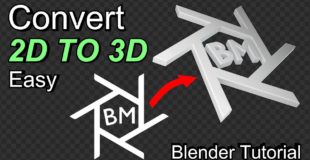https://i.ytimg.com/vi/pjxvaoMV47Q/hqdefault.jpg
Hey Everybody! In this video I will be showing you how to easily convert any 2D image to a 3D object/model in Blender. This is a very simple process. All you need to do is trace your 2D image with a curve object and then adjust the handles so they follow your picture properly. Stick around to the end if you want to learn how to make a cool wallpaper to display your logo/image.
I hope you guys enjoy this tutorial and learn something new. If you have any suggestions for future tutorials, feel free to leave them in the comments below, and don’t forget to like, subscribe, and share your results. I would also appreciate it if you guys would support me on Patreon so that I can continue to bring you guys these tutorials and help improve their quality as well.
Thanks for watching!
Links:
Sci-Fi Wallpaper Tutorial – https://youtu.be/ueC85kDBrmw
Website – http://blendmaster.weebly.com/
Patreon – https://www.patreon.com/blendmaster
Subscribe – https://www.youtube.com/c/blendmaster
source

12 responses to “How to Convert a 2D Image to 3D Object in Blender (A Basic Introduction to Curve Modelling)”
Amazing! So Cool!
Middle mouse click is rotating in 3d Space. not allowing me to move the image on just 2 axis
You didn't speed it up, You only added Music….lol
Thank you! Excellent tutorial — clear and concise!
I cant get my image to show up even if I try importing svg 🙁
Would anyone happen to know how to texture something like this?
How can i convert a simple 2d plane into a 3D object HEEEEEEEEEEEEEEELP
There isn't any way to just draw lines automaticly, is it?
BlendMaster
Do you have an idea how to convert a more complex 2d landscape picture into a 3d scene?
So that you could bring a 3d object in the middle of the 3d scene.
For example:
https://www.forumchina.de/sehenswuerdigkeiten-china/bilder/karstberge-guilin.jpg
Vectorize it via Inkscape ? Or are there any add-ons ?
Thanks for any help, idea.
Thank you. I love making logos in Blender.
Another option for anyone interested: use a polygonal mesh, set the feature set at the top of render settings to "experimental," and (for curved objects) add a subdivision modifer with adaptive subdivision on. This can give more flexibility, and you can control the curviness with creases.
thanks for the vid, very useful
"How to convert a bitmap to a vector image by hand, in Blender"
You can skip the first half if your image is already vectorized.